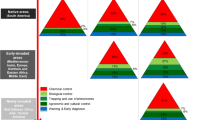Abstract
In light of a recent increase in the aphid populations on young canola (Brassica napus) in autumn in Northwestern Europe, we carried out a survey of their parasitoid species during this season. The study was done in France from 1998 to 2001 using different sampling methods. Results highlighted the presence of two main species of Aphidiinae, Aphidius matricariae and Diaeretiella rapae (and to a lesser extent Aphidius ervi) on Myzus persicae, and of D. rapae on Brevicoryne brassicae. Nine other Aphidiinae species were found occasionally as well as some Aphelinidae parasitoids and hyperparasitoids. There was no difference in parasitoid species pattern between fields in Northern and Southern France. The principal parasitoid species found in the fields were reared in the laboratory to confirm their ability to develop on the canola aphids. Aphidius matricariae and D. rapae were reared successfully on M. persicae, but a low parasitism rate was obtained for A. ervi on this aphid. This study showed that A. matricariae and D. rapae could develop on aphids on canola and that they are present naturally in canola in autumn. However, the parasitism rate is low in autumn, so the options could be the use of these parasitoids in augmentative release biological control programs or in an IPM project on canola fields during this time of the year.


Similar content being viewed by others
References
Bahana J, Karhioc GK (1986) The role of Diaeretiella rapae in population control of cabbage aphid. J Insect Sci 7:605–607
Bijaya Devi P, Singh TK, Jiten Singh H (1999) Studies on the natural enemy complex of the green peach aphid, Myzus persicae (Sulzer) on Knol-Khol, Brassica oleracea gongylodes. Annu Plant Prot Sci 7:37–40
CETIOM (2002) Le colza d’hiver, les techniques culturales, le contexte économique. Edition CETIOM, Thiverval-Grignon, France
Chow A, Mackauer M (1991) Patterns of host selection by four species of aphidiid (Hymenopera) parasitoids: influence of host switching. Ecol Entomol 16:403–410
Desneux N (1999) Effets de faibles concentrations létales et sublétales de Lambda-Cyhalothrine sur le comportement parasitaire d’Aphidius ervi sur le complexe Myzus persicae-colza. University of Tours, Tours, France, pp 27
Desneux N, Fauvergue X, Dechaume-Moncharmont FX, Kerhoas L, Ballanger Y, Kaiser L (2005) Diaeretiella rapae limits Myzus persicae populations following applications of deltamethrin in oilseed rape. J Econ Entomol 98:9–17
Eigenbrode SD, Moodie S, Castagnola T (1995) Predators mediate host plant resistance to a phytophagous pest in cabbage with glossy leaf wax. Entomol Exp App 77:335–342
Gabrys B, Gadomski H, Sobota G, Halarewicz-Pacan A (1998) Reduction of the cabbage aphid, Brevicoryne brassicae (L.), population by Diaeretiella rapae (McIntosh) on canola, white mustard, and Brassica vegetables. Bulletin IOBC/WPRS 21:197–203
Graichen K, Schliephake E (1996) Auftreten, Symptome und Vektoren des Wasserrübenvergilbungsvirus (Syn. Westliches Rübenvergilbungsvirus) am Winterraps. Nachrichtenbl Deut Pflanzenschutzd 48:186–191
Kröber T, Carl K (1991) Cereal aphids and their natural enemies in Europe a literature review. Biocontrol. News Inform 12:357–371
Lyon JP (1968) Remarques préliminaires sur les possibilités d’utilisation pratique d’hyménoptères parasites pour la lutte biologique contre les pucerons en serre. Ann Epiphyt 19:113–118
Ohiman SC, Kunar V (1986) Biological control of mustard aphid, Lipaphis erysimi by using the parasitoid Diaeretiella rapae. Influence of parasitoids on aphids. J Environ Entomol 16:219–222
Pike KS, Starý P, Miller T, Graf G, Allison D, Boydston L, Miller R (2000) Aphid parasitoids (Hymenoptera: Braconidae: Aphidiinae) of northwest USA. P Entomol Soc Wash 102:688–740
Pilorgé E, Maisonneuve C, Balanger Y (1997) Les ravageurs du colza d’hiver. Les points techniques du CETIOM. Edition CETIOM, Paris, France
Powell W, Wright AF (1991) The Influence of host food plants on host recognition by 4 Aphidiine parasitoids (Hymenoptera, Braconidae). Bul Entomol Res 81:449–453
Read DP, Feeny PP, Root RB (1970) Habitat selection by the aphid parasite Diaeretiella rapae (Hymenoptera: Braconidae) and hyperparasite Charips brassicae (Hymenoptera: Cynipidae). Can Entomol 102:1567–1578
Reed HC, Tan SH, Haapanen K, Killmon M, Reed DK, Elliott NC (1995) Olfactory responses of the parasitoid Diaeretiella rapae (Hymenoptera: Aphidiidae) to odor of plants, aphids, and plant–aphid complexes. J Chem Ecol 21:407–418
Schliephake E, Graichen K, Rabenstein F (2000) Investigations on the vector transmission of the Beet mild yellowing virus (BMYV) and the Turnip yellow virus (TuYV). J Plant Dis Prot 107:81–87
Souza BM, Bueno VHP, Paes Bueno VH (1992) Parasitoids and hyperparasitoids of mummies of Brevicoryne brassicae (Linnaeus). Rev Agric Piracicaba 67:55–62
Starý P (1966) Aphid parasites of Czechoslovakia, Junk, The Hague
Starý P (1970) Biology of aphid parasites (Hymenoptera: Aphidiidae) with respect to integrated control, Kluwer, The Hague
Starý P (1988) Natural enemies. In: Minks AK, Harrewijn P (eds) Aphids, their biology, natural enemies and control. Elsevier, Amsterdam, pp 171–184
Van Emden HF, Eastop VF, Hughes RD, Way MJ (1969) The ecology of Myzus persicae. Annu Rev Entomol 14:197–270
Vaughn TT, Antolin MF (1998) Population genetics of an opportunistic parasitoid in an agricultural landscape. Heredity 80:152–162
Wilson GB, Lambdin PL (1987) Suitability of Brevicoryne brassicae and Myzus persicae (Homoptera, Aphididae) as hosts Diaeretiella rapae (Hymenoptera, Aphidiidae). Entomol News 98:140–146
Zhang WQ, Hassan SA (2003) Use of the parasitoid Diaeretiella rapae (McIntoch) to control the cabbage aphid Brevicoryne brassicae (L.). J Appl Entomol 127:522–526
Acknowledgements
This work was done at the Laboratoire de Neurobiologie Comparée des Invertébrés, INRA, France. We wish to thank Annie Geria for experimental help, Steve Yaninek and Kris Wyckhuys for their comments on the manuscript, and Xavier VanWaetermeulen and Laurent Gillot for their help in providing fields for the sampling. This work benefited from a CETIOM/Bayer Crop Sciences France grant.
Author information
Authors and Affiliations
Corresponding author
Additional information
Communicated by Jürgen Gross
Rights and permissions
About this article
Cite this article
Desneux, N., Rabasse, JM., Ballanger, Y. et al. Parasitism of canola aphids in France in autumn. J Pest Sci 79, 95–102 (2006). https://doi.org/10.1007/s10340-006-0121-1
Received:
Revised:
Accepted:
Published:
Issue Date:
DOI: https://doi.org/10.1007/s10340-006-0121-1




